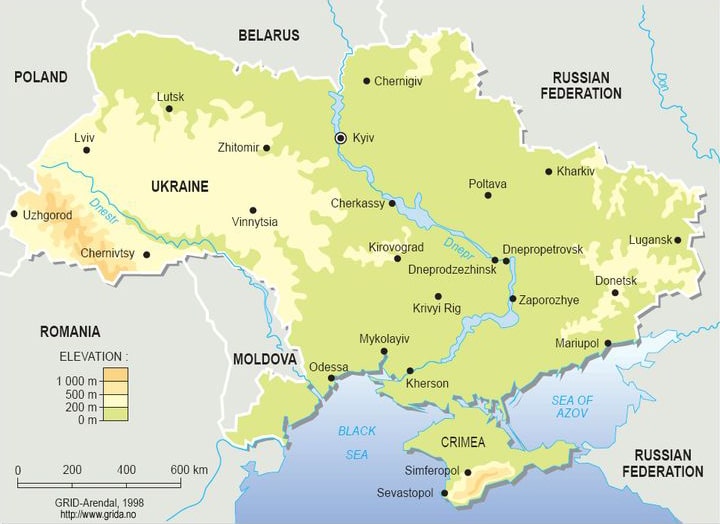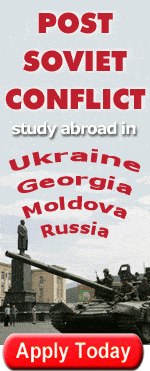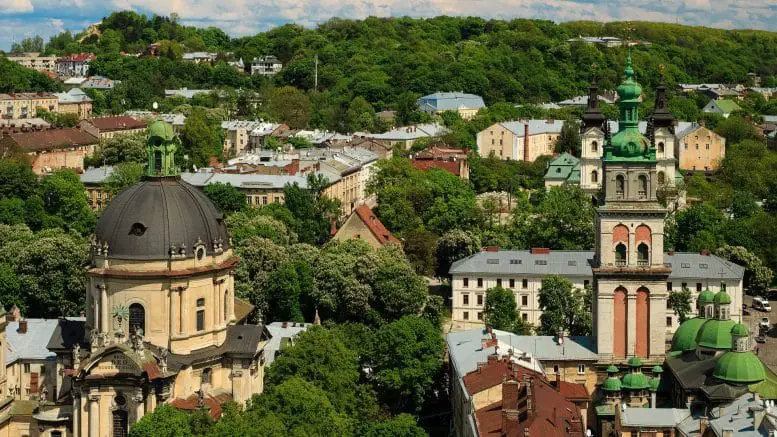With a population that is 88% ethnically Ukrainian, Lviv is one of the strongholds of what can be considered Ukrainian culture. Although it may have been founded much earlier, the city’s official founding date is 1256, when King Danylo made it the capital of Halych-Volhynia, a major province in ancient Rus’ (the predecessor of modern-day Russia) and named the settlement “Lviv” in honor of his son, Lev, which in Ukrainian means “Lion.” Today, the city is literally covered in lions – on door handles, weathervanes, and the city logo.

Topographic map of Ukraine – Lviv is in the far east, near Poland.
Lviv was founded to take advantage of major trade routes that crossed the area and also as a new military stronghold. However, in 1349 the city was captured by Poland (located just a few dozen miles away) and subsequently become the capital of the Ruthenian administrative division of the Polish Kingdom, which encompassed much of what is today eastern Ukraine. The city prospered under Polish rule and adopted many aspects of Polish culture. Lviv’s nobility adopted Polish as their language of choice and many converted to Roman Catholicism, the main religion in Poland. However, the peasantry continued to speak Ukrainian and remained largely Ukrainian Orthodox.
Many peasants would later join the Greek Catholic Church as the Union of Brest pushed into Lviv. The Greek Catholic Church has an interesting history of its own. Originally founded as an inheritor of Byzantine rites (as was the Russian Orthodox Church), the Church in Ukraine largely campaigned for unity during the great schism of the 11th century. Although they kept many of their eastern rituals, the Church (represented by the Bishop of Lviv) eventually pledged allegiance to the Pope in Rome. Lviv has, until very recently, been the capital of this religion that bridges two worlds. (The capital was moved to Kiev, and a new cathedral Greek Catholic cathedral was sponsored there by the first lady Kateryna Yushchenko-Chumachenko. The move has been very controversial among members of the Church.)

Market Square in central Lviv. The city’s Polish heritage has left it with an architectural legacy more similar to that of Europe than Russia. Here, the square is decorated for the Christmas/New Year celebration.
Following the First Partition of Poland in the late 18th century, during which the Polish empire was divided between Austria, Russia, and Prussia, Lviv fell under Austrian control and was subsequently designated the capital of the Austrian Kingdom of Galicia and Lodomeria. Under Austrian rule, Lviv continued to grow as an economic hub, as nine railways eventually converged on the city, allowing construction, trade, transport and industry to develop rapidly. The city also branched intellectually as foreign businessmen flooded in to do business and foreign scholars came to teach and be taught in the newly founded university. Ukrainian writers and artists were prolific during this period in Lviv.

Following the collapse of the Hapsburg Empire (which ruled Austria-Hungry) at the end of Word War I, a short-lived independent Republic of West Ukraine was created, with Lviv as the capital. However, the city’s turbulent fate turned once again when the troops from re-emergent Poland seized the city in 1919. The Red Army again took control in September 1939 and, in turn, Lviv was occupied by Germany from 1941 to 1944, a grim period during which 200,000 of its citizens, mostly Jews, were murdered in concentration camps. In 1944, Lviv was again taken by the Red Army. Remarkably, the city’s wealth of unique architecture was left unscathed. For this reason, UNESCO has recently named the entire city a World Heritage Site stating that “in its urban fabric and its architecture, Lviv is an outstanding example of the fusion of the architectural and artistic traditions of Eastern Europe with those of Italy and Germany.” Western architecture and art students are now flooding to the city to study these buildings.
Lviv was affected by spread of nationalist conscientiousness that swept Europe in the 19th century. Several monuments were erected at the time to Ukrainian writers and Lviv has served as an important base for Ukrainian dissidents and nationalists since then. Stalin, fearing the nationalists might move a successful campaign for independence, deported thousands from the city who were suspected as pro-nationalism dissidents or intellectuals. Ukraine would eventually declare itself a sovereign democracy, however, as the Soviet Union crumbled. On August 24, 1991 the Supreme Council of Ukraine adopted a Declaration of Independence.
Today, Lviv is growing again as an emerging market, even though the World Bank classifies it as a lower middle-income city and restoration of its fabulous buildings has been painfully slow. Lviv also suffers from the same problems that plague most post-Soviet cities, such as poor infrastructure, pollution, heavy downtown traffic, and corruption. However, despite these challenges, Lviv is becoming strong as a manufacturing center (buses, bicycles and heavy machinery are produced here) and in information technology and research and development through the city’s large number of universities and research institutes. Locals actually boast that Lviv will never “develop” along Western lines with billboards and neon blocking out its architecture because proud Lviv is “immune from tastelessness.” In 2006, Lviv celebrated its 750th anniversary.
Find Out More About Programs in Ukraine



